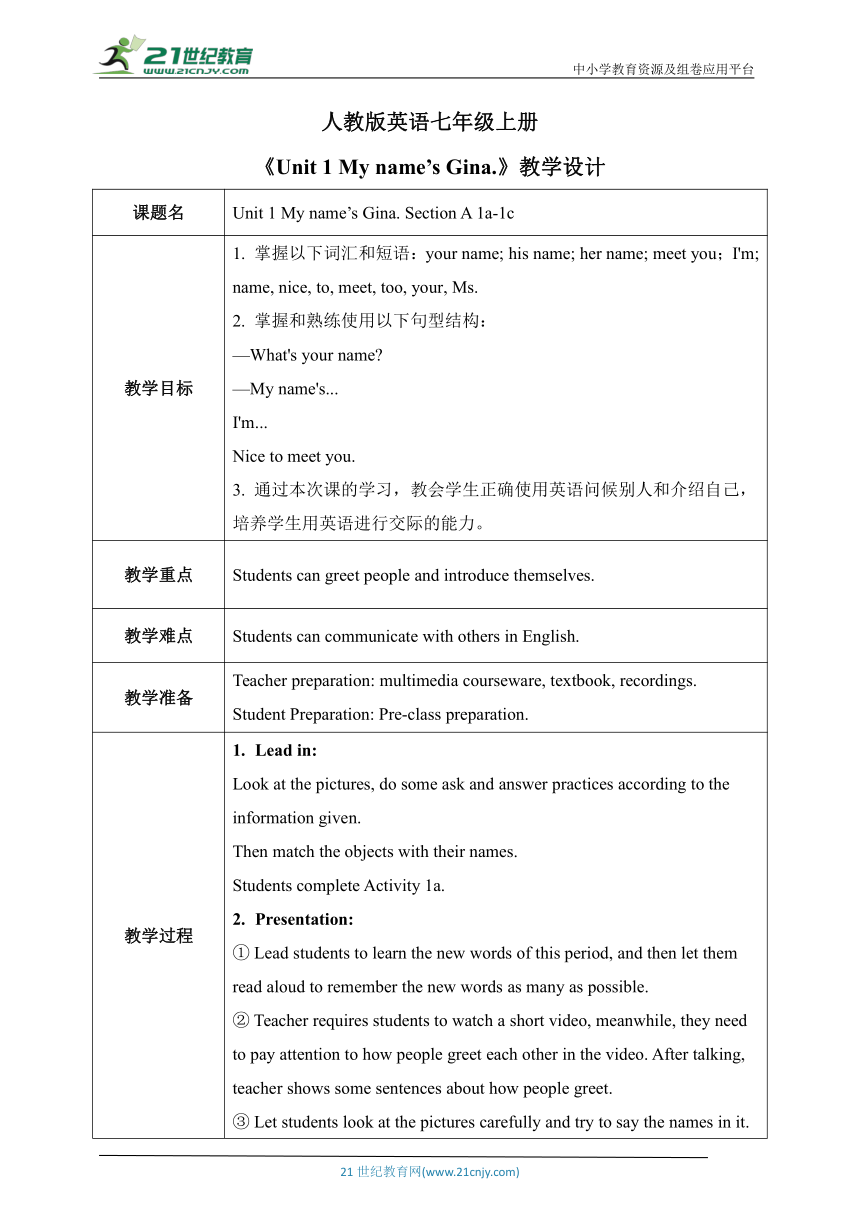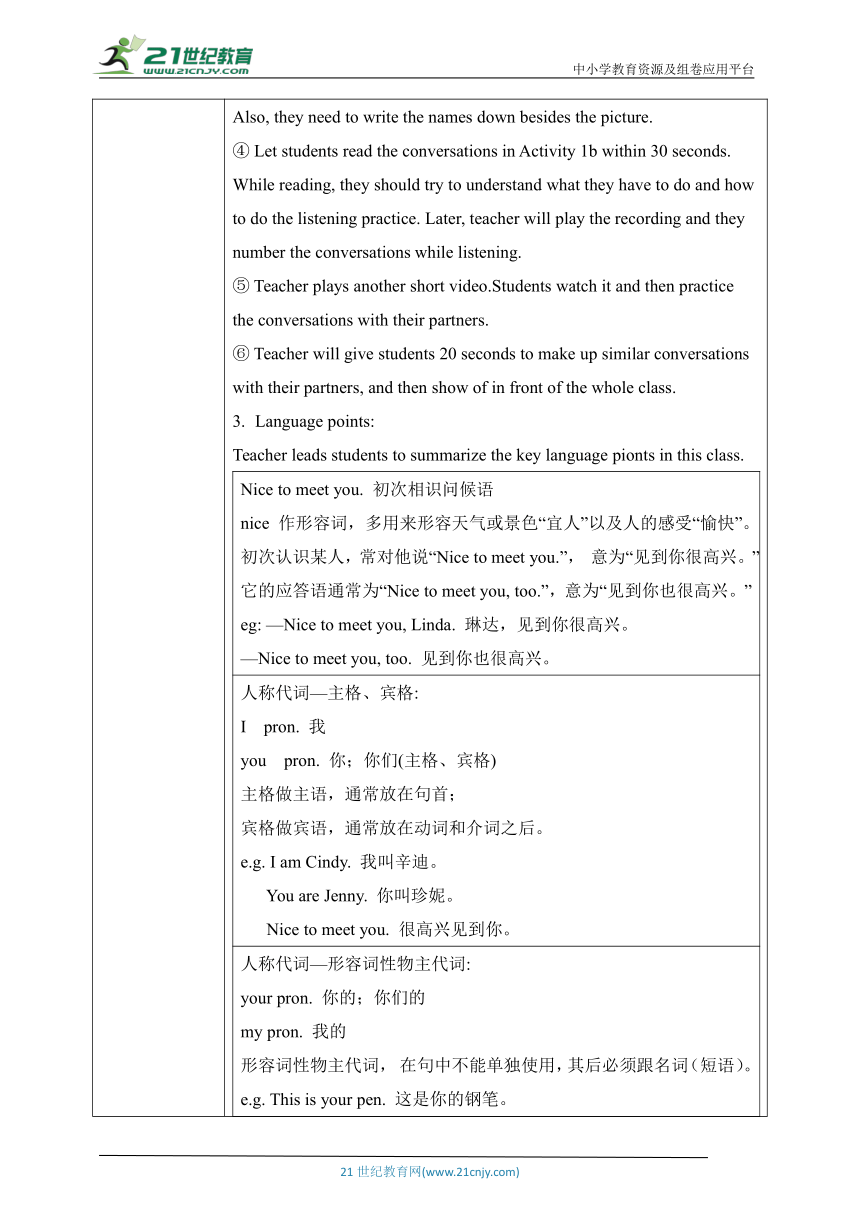【核心素养目标】Unit 1 My name's Gina. Section A 1a-1c 表格式教学设计
文档属性
| 名称 | 【核心素养目标】Unit 1 My name's Gina. Section A 1a-1c 表格式教学设计 |  | |
| 格式 | zip | ||
| 文件大小 | 1.1MB | ||
| 资源类型 | 试卷 | ||
| 版本资源 | 人教新目标(Go for it)版 | ||
| 科目 | 英语 | ||
| 更新时间 | 2022-08-22 13:00:06 | ||
图片预览


文档简介
中小学教育资源及组卷应用平台
人教版英语七年级上册
《Unit 1 My name’s Gina.》教学设计
课题名 Unit 1 My name’s Gina. Section A 1a-1c
教学目标 掌握以下词汇和短语:your name; his name; her name; meet you;I'm; name, nice, to, meet, too, your, Ms.掌握和熟练使用以下句型结构:—What's your name —My name's...I'm...Nice to meet you.通过本次课的学习,教会学生正确使用英语问候别人和介绍自己,培养学生用英语进行交际的能力。
教学重点 Students can greet people and introduce themselves.
教学难点 Students can communicate with others in English.
教学准备 Teacher preparation: multimedia courseware, textbook, recordings.Student Preparation: Pre-class preparation.
教学过程 Lead in:Look at the pictures, do some ask and answer practices according to the information given.Then match the objects with their names.Students complete Activity 1a.Presentation:① Lead students to learn the new words of this period, and then let them read aloud to remember the new words as many as possible.② Teacher requires students to watch a short video, meanwhile, they need to pay attention to how people greet each other in the video. After talking, teacher shows some sentences about how people greet.③ Let students look at the pictures carefully and try to say the names in it. Also, they need to write the names down besides the picture.④ Let students read the conversations in Activity 1b within 30 seconds. While reading, they should try to understand what they have to do and how to do the listening practice. Later, teacher will play the recording and they number the conversations while listening.⑤ Teacher plays another short video.Students watch it and then practice the conversations with their partners.⑥ Teacher will give students 20 seconds to make up similar conversations with their partners, and then show of in front of the whole class.Language points:Teacher leads students to summarize the key language pionts in this class.Nice to meet you. 初次相识问候语nice 作形容词,多用来形容天气或景色“宜人”以及人的感受“愉快”。初次认识某人,常对他说“Nice to meet you.”, 意为“见到你很高兴。”它的应答语通常为“Nice to meet you, too.”,意为“见到你也很高兴。”eg: —Nice to meet you, Linda. 琳达,见到你很高兴。—Nice to meet you, too. 见到你也很高兴。人称代词—主格、宾格:I pron. 我you pron. 你;你们(主格、宾格)主格做主语,通常放在句首;宾格做宾语,通常放在动词和介词之后。e.g. I am Cindy. 我叫辛迪。 You are Jenny. 你叫珍妮。 Nice to meet you. 很高兴见到你。人称代词—形容词性物主代词:your pron. 你的;你们的my pron. 我的形容词性物主代词, 在句中不能单独使用,其后必须跟名词(短语)。e.g. This is your pen. 这是你的钢笔。My name is Cindy. 我叫辛迪。Exercises:根据提示,完成句子:1. I’m Zhang Haowen.(改为同义句)____________is Zhang Haowen.My________(名字) is Linda.3.My name is Alan Liu. (对画线部分提问)_____________________name 4. —What’s your name, please —_________________A. I’m your teacher. B. His name is Paul.C. How do you do D. I’m Zhao Kun.根据句意及首字母提示完成单词:1. —Hello! My n__________ is Jack.—Hi, Jack. I’m Frank.2. —Hi, Linda. Is this y_________ ruler —Yes. Thanks.3. Jane’s pen is red. My pen is red, t_________.4. Nice to m_______ you, Mr. Wang.5. My pen is white a______ black.
课后作业 1. Copy the conversations in 1b.2. Make up three conversations according to 1b.
21世纪教育网 www.21cnjy.com 精品试卷·第 2 页 (共 2 页)
HYPERLINK "http://www.21cnjy.com/" 21世纪教育网(www.21cnjy.com)
人教版英语七年级上册
《Unit 1 My name’s Gina.》教学设计
课题名 Unit 1 My name’s Gina. Section A 1a-1c
教学目标 掌握以下词汇和短语:your name; his name; her name; meet you;I'm; name, nice, to, meet, too, your, Ms.掌握和熟练使用以下句型结构:—What's your name —My name's...I'm...Nice to meet you.通过本次课的学习,教会学生正确使用英语问候别人和介绍自己,培养学生用英语进行交际的能力。
教学重点 Students can greet people and introduce themselves.
教学难点 Students can communicate with others in English.
教学准备 Teacher preparation: multimedia courseware, textbook, recordings.Student Preparation: Pre-class preparation.
教学过程 Lead in:Look at the pictures, do some ask and answer practices according to the information given.Then match the objects with their names.Students complete Activity 1a.Presentation:① Lead students to learn the new words of this period, and then let them read aloud to remember the new words as many as possible.② Teacher requires students to watch a short video, meanwhile, they need to pay attention to how people greet each other in the video. After talking, teacher shows some sentences about how people greet.③ Let students look at the pictures carefully and try to say the names in it. Also, they need to write the names down besides the picture.④ Let students read the conversations in Activity 1b within 30 seconds. While reading, they should try to understand what they have to do and how to do the listening practice. Later, teacher will play the recording and they number the conversations while listening.⑤ Teacher plays another short video.Students watch it and then practice the conversations with their partners.⑥ Teacher will give students 20 seconds to make up similar conversations with their partners, and then show of in front of the whole class.Language points:Teacher leads students to summarize the key language pionts in this class.Nice to meet you. 初次相识问候语nice 作形容词,多用来形容天气或景色“宜人”以及人的感受“愉快”。初次认识某人,常对他说“Nice to meet you.”, 意为“见到你很高兴。”它的应答语通常为“Nice to meet you, too.”,意为“见到你也很高兴。”eg: —Nice to meet you, Linda. 琳达,见到你很高兴。—Nice to meet you, too. 见到你也很高兴。人称代词—主格、宾格:I pron. 我you pron. 你;你们(主格、宾格)主格做主语,通常放在句首;宾格做宾语,通常放在动词和介词之后。e.g. I am Cindy. 我叫辛迪。 You are Jenny. 你叫珍妮。 Nice to meet you. 很高兴见到你。人称代词—形容词性物主代词:your pron. 你的;你们的my pron. 我的形容词性物主代词, 在句中不能单独使用,其后必须跟名词(短语)。e.g. This is your pen. 这是你的钢笔。My name is Cindy. 我叫辛迪。Exercises:根据提示,完成句子:1. I’m Zhang Haowen.(改为同义句)____________is Zhang Haowen.My________(名字) is Linda.3.My name is Alan Liu. (对画线部分提问)_____________________name 4. —What’s your name, please —_________________A. I’m your teacher. B. His name is Paul.C. How do you do D. I’m Zhao Kun.根据句意及首字母提示完成单词:1. —Hello! My n__________ is Jack.—Hi, Jack. I’m Frank.2. —Hi, Linda. Is this y_________ ruler —Yes. Thanks.3. Jane’s pen is red. My pen is red, t_________.4. Nice to m_______ you, Mr. Wang.5. My pen is white a______ black.
课后作业 1. Copy the conversations in 1b.2. Make up three conversations according to 1b.
21世纪教育网 www.21cnjy.com 精品试卷·第 2 页 (共 2 页)
HYPERLINK "http://www.21cnjy.com/" 21世纪教育网(www.21cnjy.com)
同课章节目录
- starters 预备篇(2012秋审查)
- Unit 1 Good morning !
- Unit 2 What’s this in English?
- Unit 3 What color is it ?
- Unit 1 My name's Gina.
- Section A
- Section B
- Unit 2 This is my sister.
- Section A
- Section B
- Unit 3 Is this your pencil?
- Section A
- Section B
- Unit 4 Where's my schoolbag?
- Section A
- Section B
- Unit 5 Do you have a soccer ball?
- Section A
- Section B
- Unit 6 Do you like bananas?
- Section A
- Section B
- Unit 7 How much are these socks?
- Section A
- Section B
- Unit 8 When is your birthday?
- Section A
- Section B
- Unit 9 My favorite subject is science.
- Section A
- Section B
